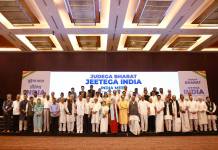Delhi government’s Water Minister, Kapil Mishra, took a water cruise in Yamuna, but it was anything but a pleasure ride. The reason behind his half-hour ride in one of the most polluted Indian rivers was to ‘take stock of the river’s condition’ of the deteriorating condition of the water quality.
The river, which receives most of Delhi’s industrial effluents is also the most important source of water supply to people in the city.
After his ‘fact-finding’ survey, Mishra said, “The Yamuna river, which has now been reduced to a dark grey-coloured lifeless river, will be cleaned within the next three years.”
The minister was accompanied by officials from various government departments, including the Delhi Jal Board (DJB) that he heads, the Delhi Pollution Control Committee (DPCC) and the Delhi Development Authority (DDA).
That the river has now been reduced to a big ‘nullah’ with no water life, low oxygen level and very high degree of pollution is self-evident. The stench emanating from the water makes one’s head swirl.
The minister surveyed an 8-km stretch between the Boat Club at Chandgi Ram Akhara and the Wazirabad Barrage, along the Signature Bridge to ITO.
In what the city government called its “first river fact-finding survey”, water quality was tested at numerous points by DJB engineers and chemists on multiple parameters.
The team took note of multiple problems like river-basin degradation, ecological pollution, contaminant effect on ecosystem and ecology, solid and liquid waste pollution and encroachment on riverbed.
“We must remember that before we think of our river Yamuna becoming a Thames or Danube, we have to first clean it with commitment. Our team at DJB has also collected various samples and performed water quality tests, which I will personally monitor,” the minister was quoted by news agency IANS.
The current level of dissolved oxygen in the river is 0.3 PPM (parts per million), while the standard is 4 PPM for maintaining water life.
“The oxygen level in the river has also gone way below what is required. We will make the river so clean that people will be able to bathe in it,” he said.
“We will make cleaning of the Yamuna a public movement. Thousands of crores were spent in the name of cleaning of Yamuna river in last 10-20 years but to no avail. There was earlier a lack of political will to clean the river,” he added.
DJB officials said 33 sewage treatment plants (STPs) exist in Delhi and 15 new STPs will be set up in the next two years.
A DJB official said, “We will have to set up 15 new STPs to treat the sewage water before it is discharged in the river. The project will be completed by 2017.”
At present, 21 nullahs (drains) carrying 850 million gallons per day of sewage empty out into the Yamuna every day.
The existing 33 STPs operational at present treat only 390 MGD of their total combined capacity of 640 MGD.
Mishra said, “The Najafgarh drain, which is the biggest polluter, needs immediate cleaning and our team at DJB has started drafting a plan to clean this. By December 2016, we will clean this drain and only treated water from Najafgarh drain will be discharged into the river.”
However, this plan has been hanging fire for over a decade now.
The only positive that seemed to emerge out of sailing down the Yamuna was the short time it took to traverse the 8-km stretch.
An uninterrupted cruise down the river will get you to ITO in 30 minutes at the most – a pleasant idea in a city choked with traffic.
















